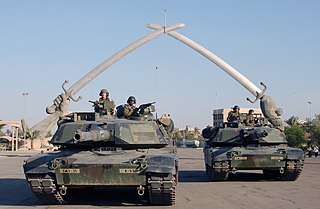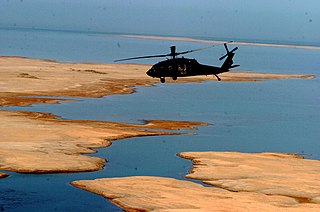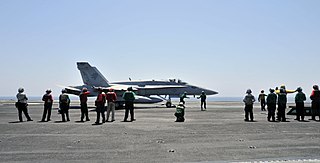Related Research Articles

Troops for the invasion came primarily from the United States, the United Kingdom and Poland, but 29 other nations also provided some troops, and there were varying levels of assistance from Japan and other countries.

The following is a timeline of major events during the Iraq War, following the 2003 invasion of Iraq.
Events in the year 2004 in Iraq.

Jama'at al-Tawhid wal-Jihad, which may be abbreviated as JTJ or Jama'at, was a militant Jihadist group. It was founded in Jordan in 1999 and was led by Jordanian national Abu Musab al-Zarqawi for the entirety of its existence. During the Iraqi insurgency (2003–11), the group became a decentralized network with foreign fighters and a considerable Iraqi membership.
Events in the year 2005 in Iraq.
The following lists events that happened during 2006 in Iraq.

The Iraq War was a protracted armed conflict that began in 2003 with the invasion of Iraq by a United States-led coalition that overthrew the government of Saddam Hussein. The conflict continued for much of the next decade as an insurgency emerged to oppose the occupying forces and the post-invasion Iraqi government. An estimated 151,000 to 1,033,000 Iraqis were killed in the first three to five years of conflict. US troops were officially withdrawn in 2011. The U.S. became re-involved in 2014 at the head of a new coalition; the insurgency and many dimensions of the armed conflict continue. The invasion occurred as part of the George W. Bush administration's War on Terror following the September 11 attacks despite no connection of the latter to Iraq.

Abu Ayyub al-Masri, also known as Abu Hamza al-Muhajir and other aliases, was the leader of Al-Qaeda in Iraq during the Iraqi insurgency, following the death of Abu Musab al-Zarqawi in June 2006. He was war minister of the Islamic State of Iraq from 2006-2010 and prime minister of the Islamic State of Iraq from 2009–2010. He was killed during a raid on his safehouse on 18 April 2010.

Al-Adhamiyah, also Azamiya, is a neighborhood and east-central district of the city of Baghdad, Iraq. It is one of nine administrative districts in Baghdad.

Abu Musab al-Zarqawi, born Ahmad Fadeel al-Nazal al-Khalayleh, was a Jordanian jihadist who ran a terrorist training camp in Afghanistan. He became known after going to Iraq and being responsible for a series of bombings, beheadings, and attacks during the Iraq War, reportedly "turning an insurgency against US troops" in Iraq "into a Shia–Sunni civil war". He was sometimes known by his supporters as the "Sheikh of the slaughterers".
Events in the year 2007 in Iraq.

Al-Qaeda in Iraq or Al-Qaeda in Mesopotamia, officially known as Tanzim Qaidat al-Jihad fi Bilad al-Rafidayn or TQJBR was an Iraqi Sunni Islamic Jihadist organization affiliated with al-Qaeda, for part of the first two decades of the 21st century.

Events in the year 2008 in Iraq.
Events in the year 2009 in Iraq.

Kata'ib Hezbollah —or the Hezbollah Brigades—is an Iraqi Shia paramilitary group which is part of the Popular Mobilization Forces that are supported by Iran. During the Iraq War (2003–2011), the group fought against coalition occupation forces. It has been active in the War in Iraq (2013–2017) and the Syrian civil war (2011–present). The group was commanded by Abu Mahdi al-Muhandis until he was killed by a US airstrike in Baghdad on 3 January 2020. Thereafter, he was replaced by Abdul Aziz al-Muhammadawi, as the new leader of the Popular Mobilization Unit (PMU).

Abu Bakr al-Baghdadi, born Ibrahim Awad Ibrahim Ali al-Badri al-Samarrai, was an Iraqi terrorist and the leader of the Islamic State of Iraq and the Levant (ISIL) from 2014 until his death in 2019.

The Islamic State of Iraq was a militant Salafist jihadist group that aimed to establish an Islamic state in Sunni, Arab-majority areas of Iraq during the Iraq War and later in Syria during the Syrian Civil War.

An American-led intervention in Iraq started on 15 June 2014, when U.S. President Barack Obama ordered United States forces to be dispatched in response to the Northern Iraq offensive of the Islamic State of Iraq and the Levant (ISIL). At the invitation of the Iraqi government, American troops went to assess Iraqi forces and the threat posed by ISIL.

The Timeline of the War in Iraq covers the War in Iraq, a war which erupted that lasted in Iraq from 2013 to 2017, during the first year of armed conflict.
In early 2014, the jihadist group Islamic State of Iraq and the Levant captured extensive territory in Western Iraq in the Anbar campaign, while counter-offensives against it were mounted in Syria. Raqqa in Syria became its headquarters. The Wall Street Journal estimated that eight million people lived under its control in the two countries.
References
- ↑ US military: Mastermind of Baghdad bombings killed, Associated press (via GoogleNews), October 4, 2008. Archived October 21, 2008, at the Wayback Machine
- 1 2 US kills 'senior Baghdad bomber', BBC News, October 4, 2008.